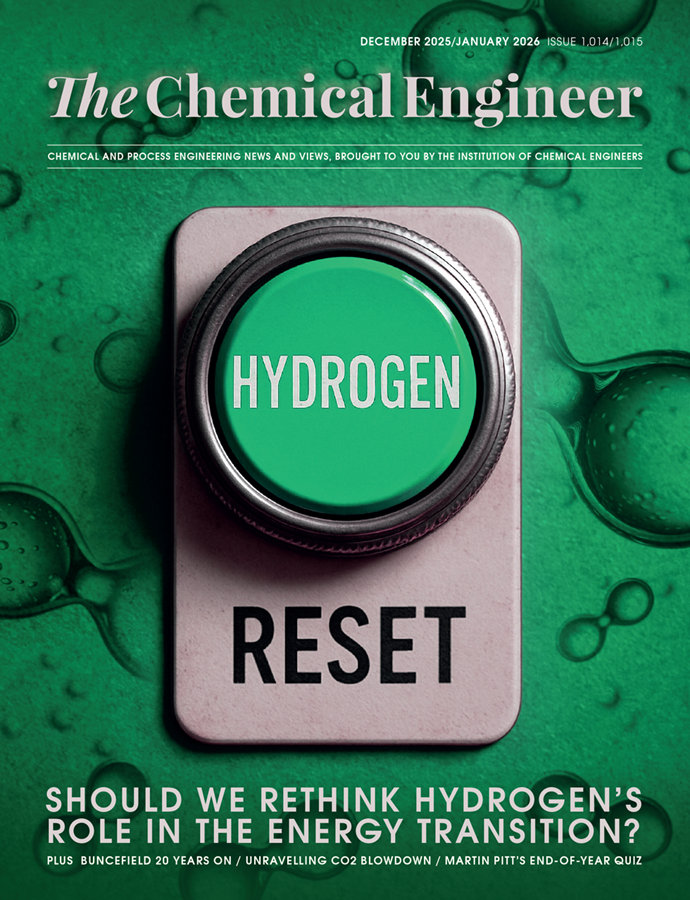Hydrogen Transport
Andy Brown looks at the options and challenges of moving hydrogen from A to B in bulk

HYDROGEN is gathering support as a potential replacement for fossil-based fuels such as coal, oil, and natural gas. In theory, and for most applications, this is an attractive option: a relatively plenteous material whose use causes only a small environmental disturbance compared to, for instance, airborne emissions of carbon dioxide or particulate materials (PM2.5 and PM10). Unlike fossil-based fuels, hydrogen needs to be processed out of something else and delivered to the point of use. This article describes some of the delivery options, the factors that can influence the choice, and some of the associated challenges.
Transporting almost any fluid requires for a number of questions to be asked, perhaps the most relevant of which are: How much? How pure? What pressure? Clearly the answers to these will depend on the end use.
How much?
For most applications, hydrogen will be used as a gas, but that does not mean that it is always transported as a gas. The majority of the hydrogen moved around has been in steel cylinders or in specially-designed and refrigerated tube trailers. Single cylinders typically contain typically 5-8 Nm3 of hydrogen at pressures ranging between 150–300 bar. BOC has the Hydrogen Genie, which is a lightweight, 20 L cylinder, which holds 7 kWh of energy and around 450 g of hydrogen.
With the increasing possibility of there being more hydrogen cars, there is the need for methods to store hydrogen that are both lightweight and safe. Compressed hydrogen can be stored on board in tanks based on type IV carbon-composite technology, an all-composite construction featuring a polymer, liner (typically a high-density polyethylene (HDPE)) with carbon fibre or hybrid carbon/glass fibre composite. The composite materials carry all of the structural loads. The pressures used are usually either 350 bar or 700 bar. Capacities vary between manufacturers, but 5 kg is typical. The design and engineering of these tanks has delivered dramatic improvements over the past 10 years, as shown in Table 1.1

Hydrogen is also stored in cryogenic conditions in insulated tanks (typically cooled to -253°C and at pressures of between 6 and 350 bar), or using advanced materials, (ie within the structure or on the surface of certain materials).
The next increment up, as it were, is hydrogen trucks. In the US, for longer distances, hydrogen is transported as a liquid in insulated, cryogenic tanker trucks. Over long distances, transporting liquid hydrogen by road is more economical than as gaseous hydrogen because a liquid tanker truck can hold a much larger mass of hydrogen than a gaseous tube trailer. Challenges with liquid hydrogen transportation include the potential for boil-off during delivery.
Typically, hydrogen is transported in tube trailers in the UK. A typical trailer (see Figure 1) would be filled to 228 bar, and would carry around 300 kg of hydrogen. There are now available on the market, high capacity 300 bar trailers, which could carry 600 kg at 228 bar and 900 kg at 300 bar. There are also 500 bar trailers in development.2

In the US, liquid hydrogen is also moved in bulk by rail in tanks which have double walls (like a vacuum flask), multi-layer insulation and sunlight reflectors.
A liquid hydrogen truck is shown in Figure 2.

LH2-sized tank cars have a capacity of 7,711 kg. The pressure within the tank is typically 1.7 bara or lower and the temperature is usually below −252.87 °C. The boil-off rate is around 0.3–0.6% per day.3
Hydrogen has been transported by pipeline since 1938. Between the Rhine and Ruhr areas of Germany a 250-300 mm diameter, 240 km long line constructed of a standard grade of pipe steel, has been carrying hydrogen at a pressure of 20–210 bar.4 Since then, hydrogen pipelines are to be found in many different countries (see Table 2) and new ones are being constructed.

More is understood about the potential metallurgical impacts when hydrogen is transported in carbon steel pipelines, particularly hydrogen embrittlement, than was in 1938. Hydrogen embrittlement is caused by the interaction of hydrogen atoms with the crystal lattices within the steel. The presence of hydrogen enhances the generation of stress corrosion cracks. Steels with body-centred cubic lattice atomic structures (ferritic steels) are susceptible under certain conditions (high tensile stresses in the material). Metals with face-centred cubic lattice atomic structures (eg austenitic steels, Al, Ni) are less susceptible. The likelihood of hydrogen embrittlement taking place can therefore be reduced by a combination of:
- lower partial pressure of hydrogen;
- lower temperatures;
- pipeline material selection; and
- conservative design (lower hoop stress).
In principle, bulk transport of hydrogen is little different from that of natural gas, and current design codes (eg BS PD 8010-1) apply. It is generally recommended5 that only lower-strength API 5 5L grades (X52 or lower) should be specified, which keeps the hoop stresses low, and allows ‘standard’ pipeline sizes, materials and welding procedures developed for natural gas to be used.
IGEM is producing guidelines for more local distribution of hydrogen by pipe. For low-pressure pipelines, the same low grades of steel, as for high and medium pressure pipelines are used, but for pressures of 7 bar and lower, non-metallic pipelines become more cost-effective, especially over long distances. There are two polyethylene materials used for low pressure water and gas infrastructure in the UK, known as PE80 and PE100.
PE80 has been widely used for gas, water and industrial applications for many years. This material was earlier known as MDPE (medium density polyethylene) and HDPE (high density polyethylene).
PE100 is a higher performance polyethylene than PE80, and demonstrates improved resistance to rapid crack propagation as well as to long-term stress cracking. PE100 also has advantages over PE80 at low temperatures, since it is extremely crack resistant down to -20°C. The higher strength of PE100 permits thinner pipe walls than PE80 for the same operating pressure: it uses less polymer material and provides for a larger bore and increased flow capacity for a given nominal pipe size. This can result in significant cost savings at certain sizes and pressure ratings.
PE80 and PE100 are not recommended globally for continuous pressure operation at temperatures above 40°C for any gases. In the UK, PE pipeline components are rated up to 7 bar pressure (10 bar elsewhere) at up to 20°C when carrying natural gas. There is currently no equivalent rating for carrying natural gas/hydrogen mixtures nor for 100% hydrogen.
Research work has been carried out, however6, to compare the permeability of PE80 for natural gas with that for hydrogen at 5 and 20 bar with a range of compositions and temperatures. Permeability was not influenced by the applied pressure, and there appeared to be no mixture effect, in other words, for a given temperature, each gas (hydrogen or methane) keeps its intrinsic permeability coefficient whatever the composition of the feed mixture. The phenomenon was consistent with Arrhenius’ Law, thus predictions could be made for pressures outside of those applied in the laboratory. Other work7 has stated that the diffusion of hydrogen through PE pipelines is five times higher than the diffusion of natural gas, but is still negligible, with an annual loss of 0.0005-0.001% of the total transported volume.
How pure?
The two purity grades most commonly produced are “high purity” (99.98% H2) and “ultra high purity” (99.999% H2, so-called “5 9’s purity’). Rarely will one find hydrogen of a lower purity being transported because there has been little market demand for it, as applications have demanded high purity. These would include fuel cells (especially proton exchange membrane (PEM) and alkaline fuel cells, and use as a coolant in large alternators). However, some types of fuel cells (eg molten carbonate) can use natural gas and bio-gas, so could also use lower purity hydrogen. Other applications use hydrogen as a reducing agent (eg in glassworks to minimise oxidation potential) which again, would not need to be of a high purity.
Delivering high purity and very high purity hydrogen in cylinders has been commonplace for decades, and this is likely to remain a market for some time into the future.
Current proposals to replace some or all of the natural gas with hydrogen open up new opportunities for hydrogen, and if “slightly impure” hydrogen can be delivered, for instance, to heat or domestic customers at a lower cost than the high purity grades, without affecting the quality of the product, it will improve the chances of a more widespread uptake.

The possibility of distributing “slightly impure” hydrogen also opens up the possibility of a wider variety of hydrogen production technologies, some of which might result in small amounts of CH4, CO or N2 being present. This would avoid the costly and unnecessary removal of these species at low partial pressures from the bulk gas, and could bring closer the move toward a hydrogen-based economy.
But what about fuel cell applications requiring a higher purity grade? Take, for instance, fuel cell vehicles, won’t this disincentivise hydrogen filling stations? Not necessarily, it means that the filling stations can draw their “slightly impure” hydrogen from a wider pipeline infrastructure and process it locally using pressure swing absorption (PSA) or molecular sieve technologies in conjunction with the high pressure compressors that would be needed anyway.
It is very probable that pure hydrogen, introduced into pipes previously used for natural gas (repurposing), will, at the required levels in the ppmv (parts per million by volume) range, pick up sufficient impurities to require pre-treatment before use in a fuel cell anyway. Hence pipeline transportation of bulk hydrogen becomes a distinct possibility, even using existing infrastructure. Still more so if hydrogen is present together with natural gas at low (eg 20 vol%) levels.
What pressure?
Hydrogen is a compressible gas, but because of the small molecular mass, centrifugal designs are not ideal, as they need to operate at tip speeds three times faster than that of natural gas compressors to achieve the same compression ratio. Because of hydrogen’s small molecule size, axial compressors are not very efficient either, as there is significant inter-stage leakage.
Hence positive displacement (reciprocating) compressors are often preferred, particularly where higher pressures are required. Positive displacement compressors can be reciprocating or rotary. Rotary compressors compress through the rotation of gears, lobes, screws, vanes, or rollers. Hydrogen compression is a challenging application for rotary compressors due to the tight tolerances needed to prevent leakage/hydrogen leakage back through the mechanism.
Reciprocating (or piston) compressors use a motor, sometimes with a linear drive, to move a piston or a diaphragm back and forth. This motion compresses the hydrogen by reducing the volume it occupies. These compressors can be large, heavy pieces of equipment. Figure 3 shows a 145 mm stroke 720 RPM compressor, taking hydrogen at 30 barg and delivering it at 50 barg. The motor power is 3.36 MW.
Ionic compressors are available today at the capacities and pressures required at hydrogen fuelling stations (>700 bar).

Ionic compressors are similar to reciprocating compressors but use ionic liquids in place of the piston. These compressors do not require bearings and seals, two of the common sources of failure in reciprocating compressors.
As a rule of thumb, hydrogen compression will require about 2.1% of the energy content of the gas itself to power the compressor. Higher compression without energy recovery will mean that even more energy will be lost during the compression step.
The answer, where possible, is to compress the source chemicals upstream (water in electrolysers, natural gas in autothermal reformers etc).
Summary
High purity hydrogen has been transported for a long time. Developing applications, like fuel cell vehicles have served to stimulate innovation to overcome perceived obstacles. The transition to a hydrogen-based economy will require bulk transport: this is not without its difficulties, but none of these seem insurmountable, and can draw significantly on the custom and practice of the natural gas industries.
This is the sixth article in a series discussing the challenges and opportunities of the hydrogen economy, developed in partnership with IChemE's Clean Energy Special Interest Group. For more entries visit the series hub.
References
1. Hydrogen Storage Materials, Department of Mechanical Engineering, Yuan Ze University; and Targets for On-Board Hydrogen Storage Systems, US Office of Energy Efficiency & Renewable Energy.
2. BOC Gases, Clean Fuels Division.
3. NREL/TP-570-25106, Costs of Storing and Transporting Hydrogen, Wade A Amos (National Renewable Energy Laboratory), November 1998.
4. https://bit.ly/2HDX1JA
5. European Industrial Gases Association doc. 121/14, Hydrogen Pipeline Systems, 2014.
6. “Durability and transport properties of polyethylene pipes for distributing mixtures of hydrogen and natural gas”, M-P Foulc et al, presented at the World Hydrogen Energy Conference, Lyon, France, June 2006.
7. WP EN2006-008 “The use of the Natural-Gas pipeline infrastructure for hydrogen transport in a changing market structure” D Haeseldonckx, W D’haeseleer, Katholieke University of Leuven, Belgium, June 2008.
Recent Editions
Catch up on the latest news, views and jobs from The Chemical Engineer. Below are the four latest issues. View a wider selection of the archive from within the Magazine section of this site.




